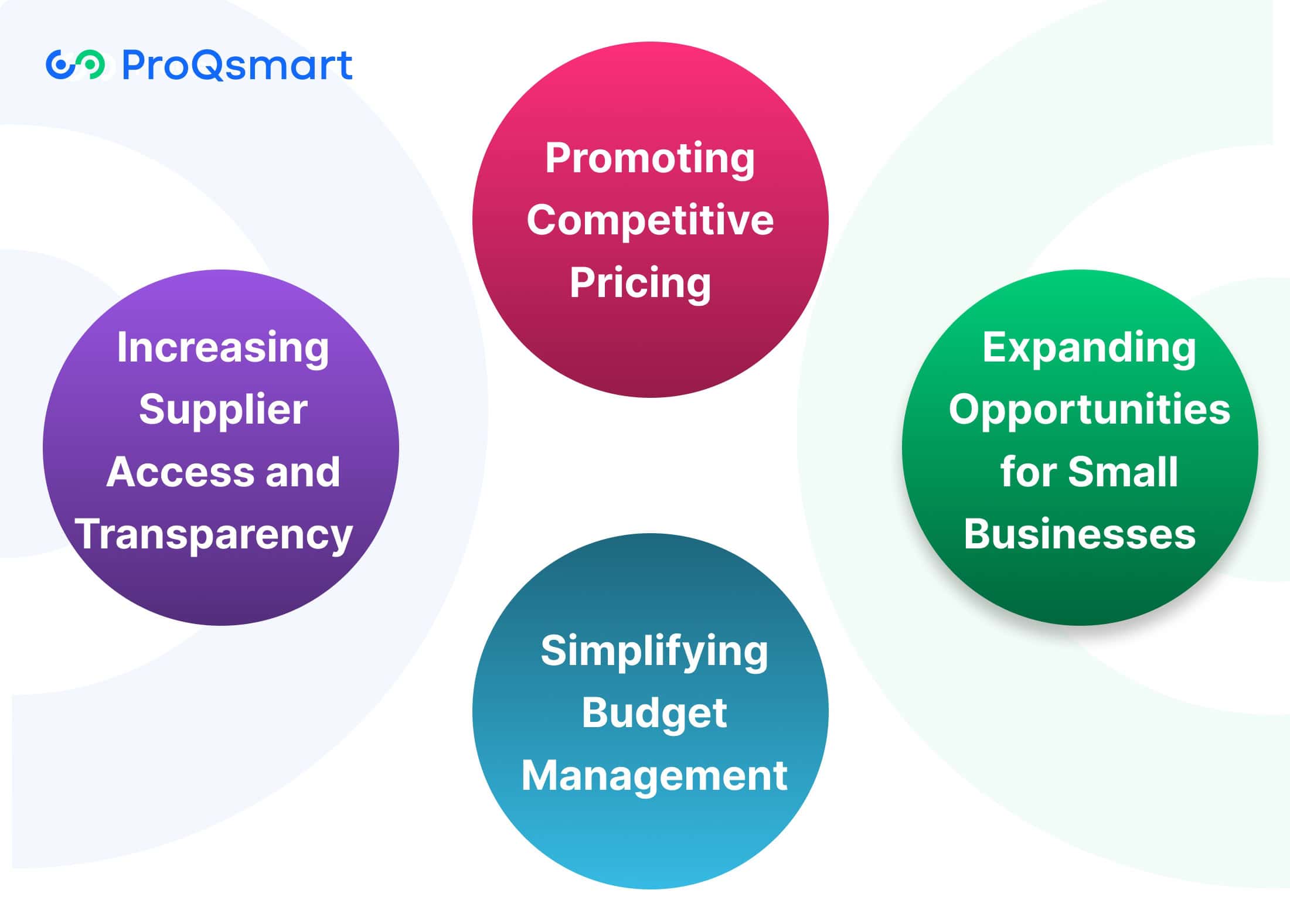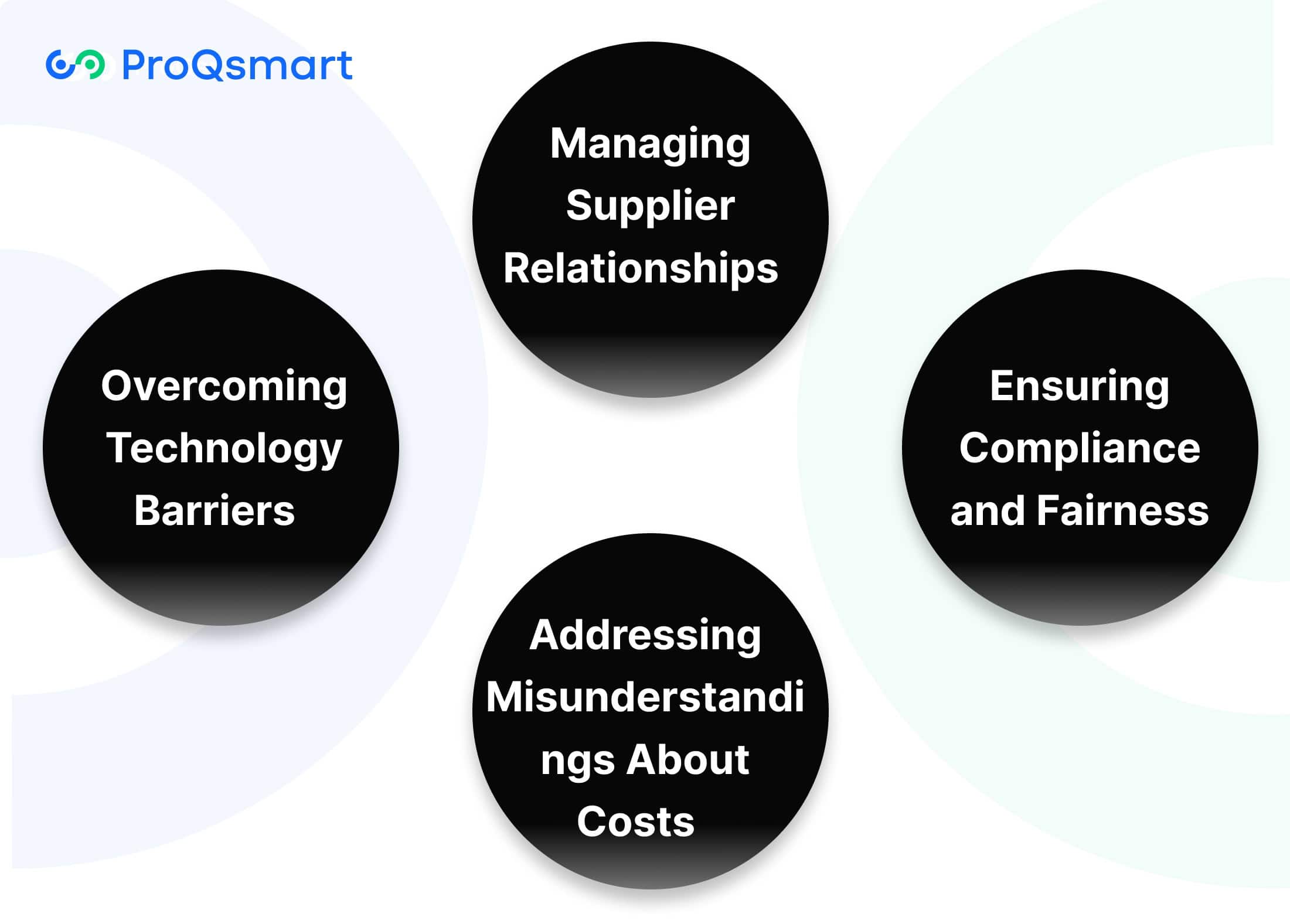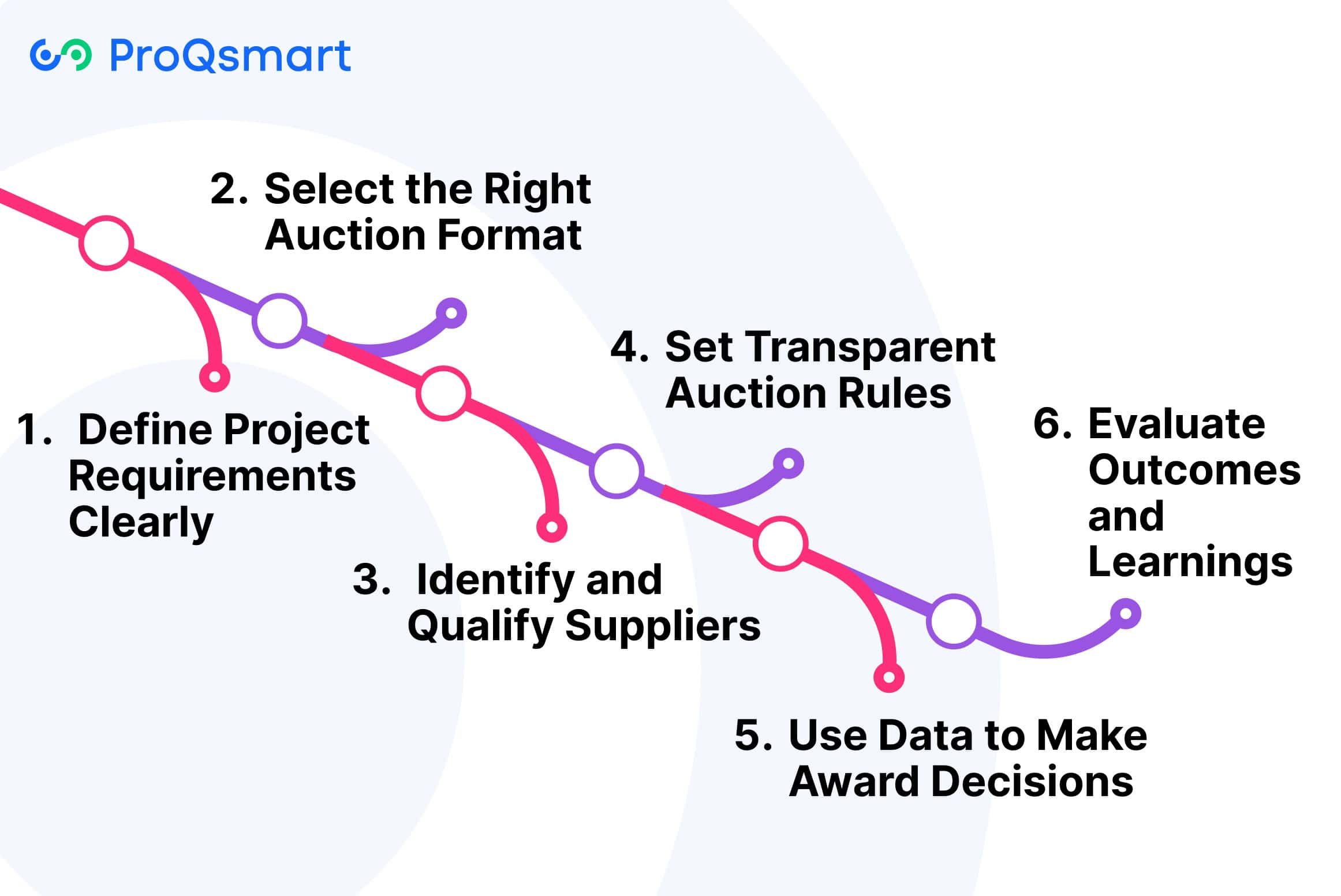Under a reverse auction, suppliers compete against each other to provide the lowest price for the goods or service. In addition to being a more transparent procurement method, this process works as a proven tool to lower costs. Unlike traditional auctions, buyers initiate the process, and multiple suppliers compete by lowering their prices in real-time.
This approach avoids favoritism in awarding contracts, promotes transparency in supplier pricing, and supports competition among suppliers. Reverse auctions are standard practice for sourcing commodities, products, or services where specifications are identical or easily defined, and efficiency and cost management are imperative.
The electronic format of reverse auctions makes the process more efficient and lessens the time spent negotiating, while improving decision making. Procurement professionals can simplify their sourcing efforts through their adoption of this strategy. They can drive huge, measurable savings without sacrificing quality or compliance.
What is a Reverse Auction?
Reverse auctions are unique in that they apply competitive bidding in a different manner. Rather than increasing costs, suppliers are incentivized to drive prices down, as they compete to provide the lowest possible price to win a contract.
This approach works best for fairly specific procurement requirements, like buying injection-molded parts of different dimensions. With reverse auctions you might spend 20% less — or $100,000 more each year. Optimization software, already widely adopted in the public sector since 2002, continues to improve that process by helping agencies find suppliers who deliver the best value.
How does Reverse Auctions Work
A reverse auction usually goes through a set process. To start, buyers first release a detailed RFQ detailing their desired specifications. Suppliers then place their opening bids on an electronic platform that allows for real-time communication.
During the auction, suppliers compete by continuously underbidding on the amount to provide the service. At the same time, the system displays the lowest unique bid in real time.
Timing is extremely important. Suppliers need to find the right balance between cutting prices and still being able to deliver quality products. Technology enables a reverse auction to provide a transparent, efficient, market-based system that is advantageous to buyers and suppliers alike.
Common Misconceptions About Reverse Auctions
One of the most pervasive myths is that reverse auctions undermine the quality of the goods or services provided. This trouble spot usually emerges when reverse auctions are inappropriately applied to procurement situations that are heavily qualitative—where the factors other than cost matter more.
A second misconception is that suppliers are afraid to participate because they feel there’s a bias. The truth is, transparency and strong anti-collusion bidding rules create a strong incentive for broad participation.
Worries about complexity are misplaced too, since today’s platforms make it easier than ever to file accurately and on time.
Benefits of Reverse Auctions

Reverse auctions are an essential tool in today’s procurement toolbox. For these reasons, reverse auctions offer organizations a smart way to save taxpayer dollars, spur competition, and increase transparency. Suppliers can respond to each other’s bids in real time through these online bidding events. That kind of competition is what drives down prices and ensures fair and efficient processes.
Read on as we explore the many benefits of reverse auctions.
Promoting Competitive Pricing
Reverse auctions foster a highly competitive environment where suppliers are forced to compete with one another by continually underbidding each other. We know that competitive pressure pushes organizations of every type to seek cost-saving efficiencies. As a result, they’re able to guarantee an average of 20% cost savings on procurement up front.
By creating a real-time bidding environment, suppliers are forced to develop more sophisticated pricing approaches that ultimately help buyers get the best final prices possible. Private sector businesses can use reverse auctions to obtain the best value on everything from simple commodities to complex toxic assets. This method simultaneously creates transparency from start to finish.
Expanding Opportunities for Small Businesses
Perhaps the greatest benefit of reverse auctions is their inclusivity. These are the kinds of suppliers, typically lost in the shuffle under traditional procurement, that get an opportunity to bid on a level playing field. Reverse auctions encourage a wider range of suppliers to compete by focusing attention on price and terms rather than scale or name recognition.
This approach encourages innovation and increases the supplier pool. This open, all-inviting approach creates a more level playing field, giving smaller businesses a truer chance to demonstrate the full range of their capabilities.
Simplifying Budget Management
Reverse auctions make it easy to plan a budget by ensuring predictable, competitive cost results. By promoting transparent bidding, buyers are able to more accurately predict costs, helping to align strict budgets more accurately. This saving is both a clear time and cost-saving benefit to operations.
Organizations leveraging platforms such as ProQsmart also benefit from advanced capabilities such as real-time budget tracking. These features, combined with automated workflows, greatly simplify their procurement processes.
Increasing Supplier Access and Transparency
More transparency into supplier capabilities is achieved through informed decision-making. Reverse auctions provide greater insight into supplier capabilities. Transparent bidding processes create accountability, allowing buyers to fairly judge suppliers on quality standards and cost.
Tools like ProQsmart increase transparency by providing functionalities like supplier performance tracking and document tracking. These tools improve supplier relationship management and enhance supplier compliance and accountability. Getting connected to dozens of suppliers through one auction platform makes it easier to source everything from janitorial services to heavy equipment.
Challenges with Reverse Auctions

Reverse auctions can be a highly effective procurement tool if they are managed thoughtfully to overcome their challenges. Both buyers and suppliers encounter obstacles that can impact the success of the reverse auction process. By familiarizing themselves with these challenges, professionals can stay ahead of potential pitfalls and ensure the best possible results in their reverse auction strategies.
Managing Supplier Relationships
Keeping suppliers happy is always important, especially when operating in the highly competitive environment of reverse auctions. This puts a lot of pressure on suppliers to cut corners on quality or service to fit within price expectations. This leads to frustration for their end customers.
For example, suppliers that are dissatisfied with new conditions might be incentivized to withdraw from competing in future auctions. When cost considerations are balanced with quality and service, procurement decisions are more likely to support an agency’s long-term goals.
Collaborative relationships incentivize new solutions and build trust, producing value far exceeding the lowest bid. Strategies such as routine performance evaluations and ongoing communication can prevent damaging effects and foster goodwill trust in the process.
Ensuring Compliance and Fairness
Following consistent auction rules is not only fair, but it safeguards the interests of buyers. Sharing all information about the process creates a level playing field for everyone, which engenders trust among all participants and protects adherence to industry standards.
For instance, mistakes in open outcry auctions, where bidders verbally give their bids in real-time, can be mitigated due to the established protocols. Buyers have advantages too; by enforcing equal opportunity for all suppliers, they minimize potential risks of disputes while creating a fair playing field with ethical practices.
Addressing Misunderstandings About Costs
One big pitfall in reverse auctions is emphasizing only the initial price. This focus on price can lead to hidden costs not being considered, like shipping, warranties, or service support, which dilute total procurement value.
Comprehensive bid evaluations should take these hidden costs into account to avoid costly surprises after the auction ends. Communication providing context for total cost implications and communicating terms and conditions are crucial to ensuring suppliers know what buyers expect.
This type of transparency is critical to allowing the most informed decision making and preventing potential conflicts further down the procurement cycle.
Overcoming Technology Barriers
Technological issues frequently prevent easy participation in reverse auctions. Clunky or confusing technology can be a major deterrent to participation, particularly when suppliers can’t figure out how to use the platform.
As an example, Japanese-style reverse auctions with downward price movements will likely need strong systems to handle longer bidding periods. User-friendly platforms, combined with sufficient training and technical support, enable participants to cut through the noise and focus on the strategy rather than the mechanics.
When accessibility is part of the process, it creates a more inclusive and positive experience for everyone, leading to better results.
Types of Reverse Auctions
There’s no one-size-fits-all reverse auction procurement method predicated on the lowest responsible bid. Whether you are a buyer or a seller, understanding these reverse auction types is key to maximizing your strategic participation. By choosing the appropriate reverse bidding system, public agencies and online businesses alike can promote transparency, cost-effectiveness, and streamlined decision-making.
Ranked Reverse Auctions
Ranked reverse auctions give participants some level of knowledge about their position compared to other bidders. Although individual bid amounts are not disclosed, suppliers do know their ranking, which creates a competitive environment. This powerful transparency encourages bidders to focus on their most competitive bids, frequently leading to significant savings for purchasers.
For sellers, ranked auctions have the added benefit of improving strategic decision-making, as they provide insight into competitiveness without revealing sensitive pricing information. Companies using reverse auction platforms such as ProQsmart also have access to tools that track auction rankings, allowing them to develop data-driven bidding strategies.
Japanese Reverse Auctions
Japanese reverse auctions use a prescribed priced-decrementing format. The buyer starts with an opening bid amount. Next, suppliers have to commit to that price as it continues to drop at predetermined intervals. Suppliers only know what the current price is and how much time is left, which makes for a highly focused experience.
This format works best in high-stakes reverse auction situations where strict budgetary constraints are needed. ProQsmart’s e-tendering features make these auctions easy and transparent, with clear tracking and real-time collaboration making it easier to customize your process.
Dutch Reverse Auctions
Dutch auctions work on a descending price basis, beginning high and then gradually reducing the price until a supplier takes the offer. This quick-fire format is well-suited for procurements with acute time sensitivities or when obtaining the lowest price available is the utmost priority.
Buyers should use detailed market research to determine a fair starting price. ProQsmart’s AI-driven analytics help figure out the best pricing strategies to make sure you get a successful outcome.
Open or English Reverse Auctions
Open reverse auctions, or English auctions, provide extraordinary levels of transparency, which is the key difference between these and sealed bid auctions. With this level of visibility, participants can continuously and quickly adapt strategies, resulting in competitive, yet collaborative, bidding.
Buyers receive deep market intelligence based on deterministic market behavior, and sellers have the opportunity to prepare and compete on the right terms. ProQsmart accelerates this process with automated workflows and auditable sourcing data, enabling quick, consistent, and compliant execution.
Steps to Conduct a Reverse Auction

Reverse auctions, a more competitive procurement approach, emphasize cost savings through a reverse bidding system where suppliers place bids against each other in real-time. Careful planning and execution are essential to avoid fiascos in this reverse auction process.
- Define project requirements clearly.
- Select the right auction format.
- Identify and qualify suppliers.
- Set transparent auction rules.
- Use data to make award decisions.
- Evaluate outcomes and learnings.
1. Define Project Requirements Clearly
Clarity in requirements is the basis of a successful reverse auction. Specific detailed specifications, including materials, quantities, and delivery timelines, allow suppliers to submit their most competitive bid possible.
For example, grouping similar items together under the heading of “Widgets” or “Gizmos” reduces confusion. If line items are too many, combining related ones to form several lots keeps the attention.
This level of precision is key to minimizing misunderstanding and confusion throughout the auction process.
2. Select the Right Auction Format
Choosing the format depends on project goals and supplier expertise. Reverse Dutch auctions, as another example, increase the degree of competitive pressure with fast paced price disclosures such as “$210,000…
Suppliers need to be nimble, as the majority of the bids are run in a matter of minutes. Matching auction types with supplier readiness is key to achieving a fair and efficient auction.
3. Identify and Qualify Suppliers
Supplier prequalification is critical to ensure reliability and diversity. Criteria such as past performance, relevant certifications, or financial stability could be included.
New platforms, such as ProQsmart, make this process quicker and easier by automating subcontractor management and supplier evaluations to improve decision-making.
4. Set Transparent Auction Rules
In this regard, transparency lays the foundation for trust. Well-defined rules, like bid increments and auction timelines, keep participants automatically updated and actively bidding.
Consistently enforcing these rules is key to building credibility and encouraging active engagement.
5. Use Data to Make Award Decisions
Data analytics help guide award decisions by comparing bids across a variety of lines and looking back at historical supplier performance.
ProQsmart’s tools, such as AI-driven sourcing and real-time budget tracking, streamline this process, keeping your project on track and in budget while meeting regulations.
6. Evaluate Outcomes and Learnings
Post-auction reviews of reverse auction procurement find execution successes, as well as opportunities for future improvement. Lessons learned from evaluations help shape future reverse auction strategies, creating a culture of continuous improvement that spurs ongoing advancements in procurement efficiency.
Strategies for Buyers in Reverse Auctions
When done with careful consideration, reverse auctions have the potential to be a very powerful tool for optimizing costs and selecting the right suppliers. Buyers need to implement reverse auction methodologies that further their procurement objectives. They need to prioritize savings in tandem with the development of robust supplier relationships.
Here are some specific strategies that can improve the success of reverse auctions.
Leveraging Data Analytics for Better Decisions
Data analytics provides the backbone of reverse auctions, providing data that can help guide decisions. Buyers can use historical purchasing data combined with market trend analysis to forecast supplier bidding behavior and find opportunities for savings.
Understanding price changes in inputs is key. It allows for better bidding parameter definition in known price environments and keeps bids in line with budgetary goals. Analytics can uncover supplier strengths, like consistent delivery or advanced manufacturing capabilities.
This knowledge empowers buyers to group assemblies, such as 25 sheet metal items, into logical packages, enhancing bid efficiency through cost-estimating technology. This level of precision not only guarantees the best cost but helps ensure suppliers are the best fit without damaging relationships.
Building Strong Supplier Relationships
Positive supplier relationships don’t start and end in reverse auctions and can lead to sustained success. Collaboration builds trust, which is necessary for ensuring predictable outcomes and keeping suppliers happy.
Strategies that buyers should avoid include those that leverage reverse auctions to cherry-pick components or squeeze costs at an unacceptable rate. Such tactics can poison relationships. Rather than resorting to the pitfalls of reverse auctions, focusing on transparency and ensuring fair competition produces savings of 18%-40% across sourcing categories.
ProQsmart can help bridge these gaps by providing dynamic tools that facilitate real-time collaboration and provide visibility into supplier performance. Combined with flawless document management, it guarantees that valuable collaborations live on well past the auction’s conclusion.
Mitigating Risks Effectively
Reverse auctions are not without risks, but proactive planning can minimize them. Common challenges include overemphasis on cost reductions or supplier underperformance. Buyers must conduct thorough risk assessments during the auction planning phase to address these concerns.
For example, grouping parts into logical packages rather than splitting them across multiple suppliers reduces logistical risks and ensures quality consistency. ProQsmart’s supplier performance monitoring tools can further mitigate risks by regularly assessing a supplier’s ability to meet contract terms, simplifying risk management processes.
Ensuring Compliance With Industry Standards
Thus, we have general compliance as a critical theme in procurement, and reverse auctions are no exception. Following the right standards helps you stay on the right side of the law and protects you from reputational damage.
Similarly, buyers should ensure that they promote transparency at every stage of the auction and do not engage in activities that risk violating the law. As an example, ProQsmart aids this effort by streamlining workflows and generating auditable sourcing data, protecting every transaction to guarantee compliance with regulatory standards.
By actively incorporating these practices, we quickly build the procurement’s framework of trust and efficiency.
Strategies for Suppliers in Reverse Auctions
Reverse auctions are a powerful, competitive procurement tool where suppliers engage in a reverse bidding system, competing against each other to drive prices down and secure business. Reducing costs fuels the reverse auction process. To address issues like cost overruns, quality defects, and schedule delays, suppliers must employ effective reverse auction strategies. Below, we dive into these strategies and more to help increase supplier success.
Preparing Competitive Yet Realistic Bids
Finding the right balance between aggressively competitive pricing and achievable bids is key. Overpromising will put your finances and operations in a bind, and underbidding can result in a lost contract. Start with a true calculation of both direct and indirect costs factoring in production, labor, and delivery.
For example, if you commit to only 80% of the capacity with 20% left reserved, this commitment provides some room for uncertainty or future challenges. Comprehensive preparation, from understanding buyer needs to market landscape analysis, equips suppliers to make data-driven bids. Tools such as ProQsmart make this possible by providing suppliers with real-time tracking and cost projections.
Highlighting Value Beyond Pricing
Price is not the only factor in reverse auctions. Suppliers should focus on quality, reliability, and customer service to stand out. Having a unique selling proposition, like a history of delivering ahead of schedule, establishes trust with the buyer.
Showcasing how you address future risks—like keeping two producers for every part in case one goes out of production—only bolsters your bid.
Adapting to Different Auction Formats
Reverse auctions have different formats, like Dutch or English auctions, all of which take a different strategy. A willingness to be flexible and knowledge of the specific rules will help you be prepared.
In addition, in descending-price auctions, speed to find a competitive floor price can be key. Understanding the nuances of the auction can help avoid miscommunication that usually results in lawsuits or damaged business relationships.
Strengthening Digital Engagement
With digital tools, there’s more room for supplier participation and communication. Platforms such as ProQsmart encourage continuous collaboration and communication, automate workflows, and promote compliance.
In addition, investing in technology makes e-tender submissions and supplier performance monitoring more efficient, alleviating frustrations often seen in more traditional methods. Engaging digitally improves your ability to manage any subcontractors you may deploy, and get your updates to buyers and suppliers in real time.
Best Practices for Reverse Auctions for Interior Fit-out Projects
Reverse auctions have become an extremely helpful tool in the procurement toolbox, especially with interior fit-out projects. When used effectively, through competition among qualified suppliers, reverse auctions can result in cost savings, increased transparency, and more efficient procurement processes.
These benefits, too, demand thoughtful planning and execution. Here are some best practices and strategies to ensure reverse auctions do more than just squeeze contractors in this low-margin, niche industry.
Using Digital Tools for Efficiency
Digital tools are at the core of today’s reverse auctions, providing a simple and effective way to bid and compete. Platforms such as ProQsmart enhance this through streamlined e-tenders, automated workflows and real-time collaboration.
These automated tools help minimize human error, expedite the evaluation process and help maintain adherence to procurement regulations. For example, reverse auctions held on sophisticated platforms can result in savings of 15 – 20% in a matter of hours.
Automation increases productivity by providing more accurate bid comparisons. It expedites the decision-making process, helping projects stay on time and on budget.
Fostering Transparent Communication
Timely and open communication goes a long way in creating mutual trust and cooperation, thereby setting the stage for a successful reverse auction. Setting expectations up front, like what criteria they are using to evaluate or how they are scoring (weighted scoring – i.e price at 55%) creates transparency.
ProQsmart takes this process a step further, providing the best visibility into bidding activities. This lowers the opportunity for collusion and serves to better align supplier interests with buyer goals.
These regular feedback loops not only improve the process on an ongoing basis, but they help build positive relationships with suppliers.
Balancing Cost and Quality Priorities
Achieving the right balance between cost and quality is critical in interior fit-out projects. While reverse auctions focus on competitive pricing, it’s important to evaluate supplier proposals holistically.
ProQsmart’s supplier performance monitoring allows buyers to assess vendors based on past performance and contract compliance, ensuring high-quality materials and services. This approach not only delivers immediate budget savings but supports long-term project success by minimizing rework and delays.
Regularly Reviewing and Refining Processes
Continuous refinement of auction processes ensures adaptability to changing market conditions. Feedback from stakeholders can identify inefficiencies, enabling improvements in future auctions.
For example, ProQsmart’s real-time tracking and auditable sourcing data provide insights that support better decision-making. Regular reviews of supplier performance and procurement strategies ensure alignment with evolving project demands and industry trends.
Conclusion
Reverse auctions are a natural tool for achieving transparency and realizing savings by making the sourcing process more efficient. When run with a strategic vision, they foster a competitive environment that produces the best outcomes for both buyers and suppliers. With transparency, preparation and collaboration as guiding principles, the private sector can reap significant rewards from this process.
For buyers, reverse auctions streamline procurement, offering a fair and structured way to evaluate bids. For suppliers, they open doors to new opportunities and markets. Success depends on understanding the process, setting clear goals, and staying adaptable.
Whether you’re trying to source materials for a new project or are looking to diversify your supplier base, reverse auctions can play a key role in your overall strategy. To take your procurement strategy to the next level, consider leveraging advanced reverse auction tools like ProQsmart. This innovative platform automates reverse auctions, enhances transparency, and improves supplier engagement, allowing you to focus on strategic decision-making rather than administrative tasks.
Ready to transform your procurement processes and drive better outcomes? Book a demo with ProQsmart today!




